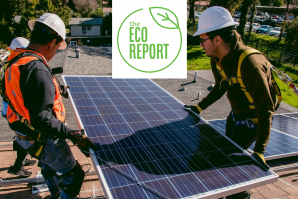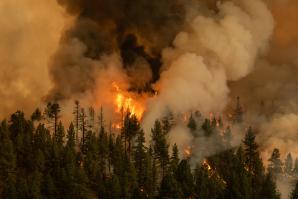Every summer and fall for the past decade, California’s wildfires have been getting larger and more destructive. Eight of the 10 largest forest fires in California history have occurred in the last five years. The California Department of Forestry and Fire Protection reports that in 2021, wildfires burned more than 3 million acres and destroyed 3,629 homes. These included the Dixie Fire, the second largest in state history, which consumed just shy of 1 million acres, more than 1,500 square miles.
Scientists blame two things for the rise of the megafire. First, global climate change, which fuels wildfires, drought and insect infestation, has dried out forests everywhere, killed more than 100 million trees in the Sierra Nevada and given birth to weather systems that feed infernos. Second, is the overabundance of forest fuels resulting from the mismanagement of wildland. Policies enforcing the practice of extinguishing every wildfire removed nature’s system of managing the buildup of fuels, both standing dead trees and accumulated biomass on the forest floor. One solution to this problem is forest thinning — the harvest of unmarketable trees and other woody biomass. Wildland managers are also increasing the use of prescribed burns, which seek to bring back a practice that indigenous people throughout the West employed for millennia to prevent fuel from accumulating.
The California Wildfire & Forest Resilience Task Force is part of a $1 billion effort to fundamentally change the ways forests throughout the state are managed. It involves all of the land management agencies managing California’s forest — state, federal and tribal — as well as representatives of private forestland owners, including logging companies and individuals. Its mission is to establish “healthy and resilient forests that can withstand and adapt to wildfire, drought and a changing climate.”
One of the primary ways the task force is working to achieve that goal is through forest thinning. Its published plan includes a directive to use this harvest to help “build a sustainable wood-products market in California.” Because this wood has no value as lumber, there have been hopes, in the three years since the task force convened, that it might be used as a source for biofuel. In recent years, several companies in Northern California have developed technologies that can do just that — turn wood waste into fuel.
West Biofuels’ Woodland Development Center is at work turning wood chips into syngas (synthetic gas), which can be converted into liquid fuels or energy. West Biofuels also uses biomass to make ethanol and methane.
Working with the California Energy Commission, UC Davis, the Sacramento Metropolitan Utilities District and other partners, West Biofuels is developing technology specifically designed to turn biomass residue from sustainable forest management practices into renewable electricity. The company is also building a modular system that can be deployed directly to the sites where forest fuel reduction projects are taking place.
The biggest player in the global wood-waste biofuel business is Aemetis, based in Riverbank in Stanislaus County. It signed a $1 billion deal to provide sustainable aviation fuel to Delta Air Lines in October 2021 and a $1.1 billion deal with American Airlines in December. The company uses woody biomass to manufacture fuel that cuts the carbon impact of air travel, which is responsible for putting more than 800 million metric tons of CO2 into the atmosphere every year. Its biomass technology has the potential to provide the sustainable wood-products market California needs to turn forest fuels into a viable clean energy industry.
An emerging industry
When Aemetis Chairman and CEO Eric McAfee was 14 years old, his grandmother gave him and his brother 400 acres of land east of Fresno, and the boys started a company. In their teenage years, McAfee recalls, he and his brother Mark grew McAfee Farms to 2,200 acres of agricultural land producing row crops. They built a dairy farm and eventually put in 520 acres of almond orchards.
While helping run the farm, McAfee attended Merced College and Fresno State. He went on to receive post-graduate certificates from Stanford and Harvard universities. Over the next couple of decades, according to his Bloomberg profile, McAfee funded more than 20 companies, including four public companies. McAfee, who has a home in Lincoln, has served for 27 years on the board of directors of the California Manufacturers & Technology Association in Sacramento.
With Aemetis, McAfee is building a plant that he says will manufacture more than 25 million gallons of jet fuel annually by drawing hydrogen from waste wood derived from spent almond trees.
Almond trees produce nuts for 18 to 20 years and are then cut down, bulldozed into piles and burned, McAfee says. This results in a massive release of carbon pollution into the Central Valley airshed. McAfee says he decided those trees presented a unique opportunity to reduce the flow of carbon dioxide into the atmosphere.
“Trees are made of molecules. Trees pull CO2 — carbon dioxide — from the air, and they pull H2O — water — from the ground. And they put the hydrogen and carbon and oxygen together into various molecules, and that’s what makes a tree.”
Eric McAfee, Chairman and CEO, Aemetis
“I grew up as a farmer and I understand something about trees,” he says. “Trees are made of molecules. Trees pull CO2 — carbon dioxide — from the air, and they pull H2O — water — from the ground. And they put the hydrogen and carbon and oxygen together into various molecules, and that’s what makes a tree.” He says his company takes those molecules apart, uses the hydrogen to make energy, and puts the carbon underground in its carbon dioxide injection well.
The patented process Aemetis will employ to extract the hydrogen from the wood, which was funded by the California Energy Commission and the U.S. Department of Energy, is revolutionary.
Colin Murphy, a biofuels expert and deputy director of the UC Davis Policy Institute for Energy, Environment, and the Economy, says West Biofuels’ and Aemetis’ technology solves a difficult problem. The three main molecules that make up wood — cellulose, hemicellulose and lignin — do not want to give up their structural integrity and are excellent at defending it, to the point that the only things that can eat wood are termites.
He points out that wood — even soft wood — is pretty tough stuff. “Trees survived and evolved over billions of years because they didn’t want animals to be able to eat them and break down the molecules that they made themselves out of,” he says.
“This represents not only a real big improvement over petroleum, but a big improvement over most of the projects that are on the market making renewable diesel or renewable jet fuel.”
Colin Murphy, biofuels expert and deputy director, UC Davis Policy Institute for Energy, Environment, and the Economy
Yet Murphy describes Aemetis’ work as a significant breakthrough in the biofuels industry. “This represents not only a real big improvement over petroleum,” he says, “but a big improvement over most of the projects that are on the market making renewable diesel or renewable jet fuel.”
Farm to fuel
McAfee has made a lot of money for himself and his investors while helping to solve global climate change, which is taking center stage as one of the biggest problems in the world. An important component of his success has been his ability to access federal, state, and private-sector programs and funds targeting global warming.
McAfee reports his company has received a total of $57 million in grants and tax incentives. In March 2021, seven months before inking the Delta Air Lines deal, Aemetis received a sales tax exclusion worth more than $1 million from the California Alternative Energy and Advanced Transportation Financing Authority to help pay for the expansion of the company’s cluster of dairy biogas production facilities. The company had previously received a sales tax exclusion worth more than $725,000.
In addition to orchard wood, Aemetis plans to utilize
forest waste wood at its new plant, but that piece of the project
is on hold, at least for now, McAfee says. Even with the state
covering the expensive and energy-
intensive work of harvesting wood for its fire-control
treatments, it’s still a haul to get the biomass out of the
forest, down mountain roads and to the company’s facility.
As of this moment, and it could change, it does not pencil out for Aemetis to apply its technology to forest waste wood. Aemetis could make a profit turning orchard wood into a key biofuel ingredient because California’s cap-and-trade program, launched in 2013, provides a funding source: the California Air Resources Board’s Low Carbon Fuel Standard credits program. Energy producers that exceed the state’s carbon emission limits could purchase credits from Aemetis — a company with emissions below state limits — to offset their pollution.
McAfee reports that 65 percent of Aemetis’ revenue comes from LCFS credits. So why does this system that works in an orchard not work in a forest?
The waste wood from the almond trees Aemetis will process can be easily measured, and the amount of carbon pollution being offset can be easily calculated. Not so with forest waste.
At UC Davis, Murphy was part of a work group sponsored by California to figure out how to use fire-control residue for bioenergy and biofuel production. That effort stalled.
“Part of the problem,” he says, “is that the models for fire risk are not precise enough, and not calibrated and validated across a wide variety of terrains and ecosystems. As a result, CARB doesn’t yet feel confident about attaching a financial incentive” to utilizing wood harvested in forest resilience efforts.
Tim Robards, division chief of Cal Fire’s Climate and Energy Program, manages the Forest Health Grants program and agrees the unavailability of LCFS credits for forest biomass is a serious problem. His agency’s grant program has a half-billion dollars under management, some of which is meant to fund its Wood Products and Bioenergy program.
Robards is a forester with a Ph.D. from UC Berkeley in statistics. “I count trees in sophisticated ways,” he says with a laugh. He describes wildfire science at the moment as “squishy” when it comes to carbon-emissions savings. “You have to predict the probability of fire returning to an area,” he says, “and predict the fire intensity. Basically it’s a modeling exercise, but it involves landscape-level fire models dealing with different treatments and different local conditions and different weather scenarios.”
Robards says he also wishes the LCFS program somehow included property administered by the federal government, which manages more than half of the forest land in the state. And he recommends that the program establish woody biomass from Northern California as a priority.
Meanwhile, as California stretches its energy and climate change policies in new directions, the rest of the world is developing similar solutions. Murphy is excited about the expansion of policies much like the LCFS. And, he points out, there’s important work being done at the federal level. Meanwhile, he says, the technology continues to evolve, largely as a response to these policies.
“Nobody has cracked the code yet,” he says, “but there are some ambitious policies in place and some innovative technology is on the way. There isn’t anything that’s going to save us anytime soon, but we can hope to get there.”
–
Stay up to date on business in the Capital Region: Subscribe to the Comstock’s newsletter today.
Recommended For You

Energy Justice for All
Efforts to secure an equitable clean energy revolution are making headway, but there’s still a long way to go
As the clean energy movement gains momentum, issues about the
accessibility and affordability of clean energy technology —
particularly among disadvantaged communities — are
taking center stage.

Final Frontiers
How the obstacles and allure of small-town startups impact rural innovation
As remote work continues to be normalized within the technology industry, techies are migrating to the Sierra Nevada foothills of Northern California. Several local tech entrepreneurs share their successes and hurdles.

Earth, Wind and the Fire Next Time
Climate change is a factor in California’s rampaging wildfires, but not the only one
Due to human influence, three primary ingredients of wilderness fires are on the rise: the accumulation of biofuels in the forest, rising heat of the planet as a whole, and an ineffective political system of fire management.

The Transportation Revolution
How we get around is rapidly evolving, and more change is coming
Several public and private sector partnerships are helping to position the Capital Region as a leader in the new mobility revolution.
Part of this month’s Innovation issue




